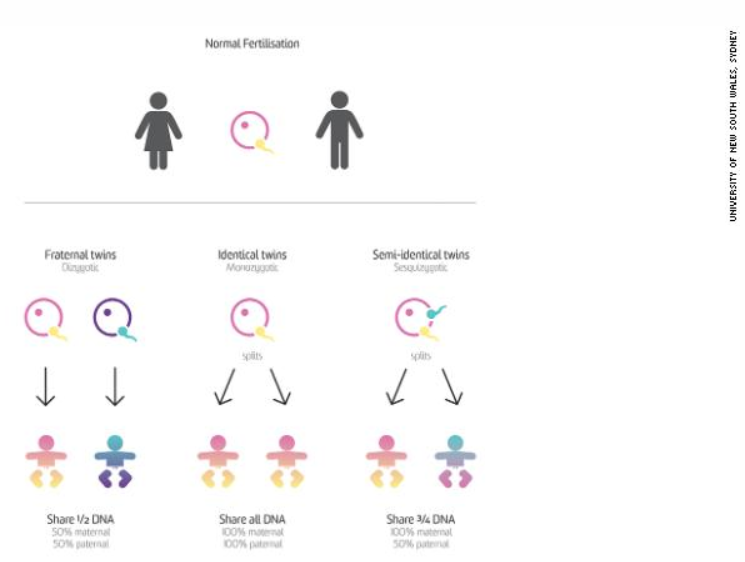
Did you know there is a third type of super rare twins?
CNN – They’re known a sisquizygous or “semi-identical” twins.
And they’re extremely, extremely rare. The only other reported case of sesquizygotic twins was reported in the United States in 2007. The recently identified twins from South East Queensland are now 4 years old and healthy.
How were they discovered?
Authors of the study were observing a 28-year-old woman’s pregnancy in 2014 when they noticed her set of twins shared a placenta, appearing to be identical twins.But the 14-week ultrasound showed they were different genders — making it impossible for them to be monozygotic twins.
These twins were formed when a single egg was fertilized by two sperm — something that shouldn’t happen, Dr. Nicholas Fisk, who participated in the study and serves as the deputy vice chancellor of research at the University of New South Wales, told CNN.
That’s because, he said, once a sperm enters the egg, the egg locks down in order to prevent another sperm — from the thousands swimming around — from entering.

According to the case study released in February in the New England Journal of Medicine, the summary states,
Sesquizygotic multiple pregnancy is an exceptional intermediate between monozygotic and dizygotic twinning. We report a monochorionic twin pregnancy with fetal sex discordance. Genotyping of amniotic fluid from each sac showed that the twins were maternally identical but chimerically shared 78% of their paternal genome, which makes them genetically in between monozygotic and dizygotic; they are sesquizygotic. We observed no evidence of sesquizygosis in 968 dizygotic twin pairs whom we screened by means of pangenome single-nucleotide polymorphism genotyping. Data from published repositories also show that sesquizygosis is a rare event. Detailed genotyping implicates chimerism arising at the juncture of zygotic division, termed heterogonesis, as the likely initial step in the causation of sesquizygosis.
What is chimerism? I am so glad you asked!
“Chimerism is a condition whereby a person has not one but two complete genomes (sets of DNA) in their body. One genome is found in one region or organ(s), while the other genome can be predominant in other organs or tissues. So a DNA test result would be entirely different depending on where the sample was originally from (blood, saliva, fingernail clippings or hair, etc).”
Want to really blow your mind? Read this report about chimerism in Giving Birth to Your Sibling’s Baby.
One mother’s story
Perhaps the most famous example of a human chimera is Lydia Fairchild. Lydia applied for child support for her two children after separating from her husband in 2002. At the time, she was pregnant with their third child. She was required to prove a biological relationship to the kids, so she submitted DNA samples for routine DNA relationship testing. Her husband was confirmed as their biological father, but the test indicated she was not the mother.
How could this be possible? Lydia conceived both of her kids naturally, carried them to term, gave birth, and was being told she was not their mother. Without knowledge of her condition, Lydia was accused of fraud. She nearly lost her two children to child protective services.
Lydia was court ordered to have a witness present at the birth of her third child to take a DNA sample immediately following the birth. Again, the third child’s DNA test excluded her from being the mother. Thankfully, a geneticist thought to test her cervical cells’ DNA, and indeed that DNA matched her son’s genome. In essence, Lydia had delivered a child from her twin, thereby becoming both the child’s mother and biological aunt. Take a moment to let that sink in.What causes chimerism?
There are many types of chimerism, and various root causes. For the type of chimerism mentioned in this blogpost (also known as ‘tetragametic’ chimerism), the most common cause is a twin pregnancy that naturally reduces to a single baby. This is referred to “vanishing twin syndrome” because one embryo doesn’t survive and the embryo’s cells are absorbed by its twin and the mother. The remaining embryo incorporates the disappearing (“ghost”) twin’s cells into various tissues and develops to a healthy baby.
On A Side Note (Opinion)
Something to thing about.
